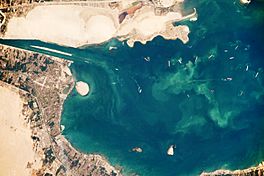Great Bitter Lake facts for kids
Quick facts for kids Great Bitter Lake |
|
|---|---|
 |
|
| Coordinates | 30°20′N 32°23′E / 30.333°N 32.383°E |
| Lake type | salt lake |
| Primary inflows | Suez Canal |
| Primary outflows | Suez Canal |
| Basin countries | Egypt |
| Surface elevation | 0 m (0 ft) |
The Great Bitter Lake (Arabic: البحيرة المرة الكبرى) is a large saltwater lake in Egypt. It is an important part of the Suez Canal, a famous waterway that connects the Mediterranean and the Red Sea. The canal also runs through the Small Bitter Lake, which is connected to the Great Bitter Lake.
Before the Suez Canal was built in 1869, this area was a dry valley full of salt. Even very old Egyptian writings, called the Pyramid Texts, mentioned this place. Ships using the Suez Canal often use the Great Bitter Lake as a "passing lane." This means they can wait here, change their position in line, or even turn around.
Why is the Great Bitter Lake so Salty?
The Great Bitter Lake is very salty because it used to be a dry valley full of salt. This natural saltiness still affects the lake today. The amount of salt in the lake depends on how much seawater flows into it from the Red and Mediterranean seas.
When the Six-Day War happened in 1967, the Suez Canal was closed for eight years. During this time, the lake became much saltier. Even when the canal is open, the Great Bitter Lake has more than twice the salt level of the sea. This makes it hard for many plants to grow there. However, many animals, like crabs, travel through the area from the Red Sea.
The Suez Canal does not have locks, which are like water elevators for boats. This means seawater flows freely into the lake from both the Mediterranean and Red seas. North of the lakes, the water current changes with the seasons. It flows north in winter and south in summer. South of the lakes, the current changes with the tides of the Red Sea.
Many fish also travel from the Red Sea to the Mediterranean Sea through the canal. This movement is called Lessepsian migration. It means that some Red Sea species have started living in the eastern Mediterranean Sea.
The Quincy Agreement
On February 14, 1945, during the last year of World War II, an important meeting happened at the Great Bitter Lake. U.S. President Franklin D. Roosevelt met Saudi Arabia's King Abdulaziz. This meeting took place on a naval ship called the USS Quincy.
President Roosevelt had just come from the Yalta Conference, where he met with Winston Churchill and Joseph Stalin. A U.S. Marine Corps officer named Bill Eddy was President Roosevelt's interpreter. He wrote about their conversation in his book, FDR Meets Ibn Saud. A BBC documentary called Bitter Lake (2015) also tells the story of this meeting.
The Yellow Fleet
During the Six-Day War in 1967, the Suez Canal was closed. Egypt kept it closed until 1975. This trapped 15 ships in the Great Bitter Lake. These ships became known as the "Yellow Fleet." They got this name because desert sands soon covered their decks, making them look yellow.
The crews of these trapped ships worked together. They shared their supplies and even set up their own post office and made their own stamps. Two ships from Germany eventually managed to sail out of the canal on their own. The cargo on the stranded ships included things like eggs, fruit, T-shirts, and a large load of toys meant for a store called Woolworth's.
See also
 In Spanish: Gran Lago Amargo para niños
In Spanish: Gran Lago Amargo para niños

